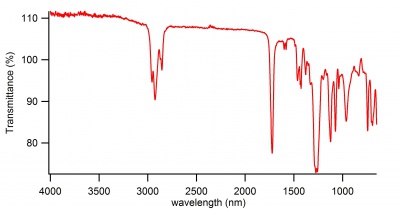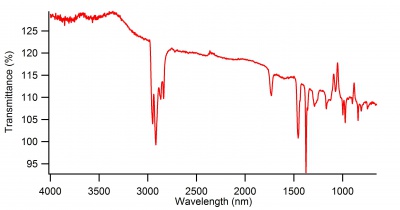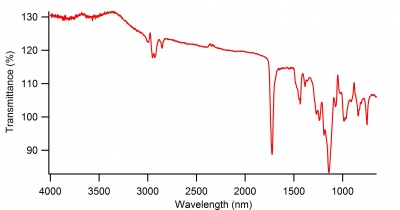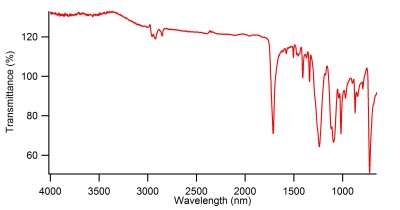Difference between revisions of "FT-IR (Nicolet)"
| Line 41: | Line 41: | ||
Fourier transform infrared spectroscopy (FTIR) is a technique which is used to obtain an infrared spectrum of absorption or emission of a solid, liquid or gas. An FTIR spectrometer simultaneously collects high spectral resolution data over a wide spectral range. This confers a significant advantage over a dispersive spectrometer which measures intensity over a narrow range of wavelengths at a time. Rotational–vibrational spectroscopy is a branch of molecular spectroscopy concerned with infrared and Raman spectra of molecules in the gas phase. Transitions involving changes in both vibrational and rotational states can be abbreviated as rovibrational (or ro-vibrational) transitions. | Fourier transform infrared spectroscopy (FTIR) is a technique which is used to obtain an infrared spectrum of absorption or emission of a solid, liquid or gas. An FTIR spectrometer simultaneously collects high spectral resolution data over a wide spectral range. This confers a significant advantage over a dispersive spectrometer which measures intensity over a narrow range of wavelengths at a time. Rotational–vibrational spectroscopy is a branch of molecular spectroscopy concerned with infrared and Raman spectra of molecules in the gas phase. Transitions involving changes in both vibrational and rotational states can be abbreviated as rovibrational (or ro-vibrational) transitions. | ||
| − | [File:FTIR instrument.png|400px|thumb|left|FTIR instrument] | + | [[[File:FTIR instrument.png|400px|thumb|left|FTIR instrument]]] |
| − | [File:FTIR_cheatsheet_2.gif|400px|thumb|left|FTIR_cheatsheet] | + | [[[File:FTIR_cheatsheet_2.gif|400px|thumb|left|FTIR_cheatsheet]]] |
Revision as of 21:05, 25 February 2016
Model
Thermo Nicolet Nexus 470 FT-IR
User manual : http://mmrc.caltech.edu/FTIR/Nicolet/Nicolet%20Software/Nicolet%202/4700_6700_User.pdf
Operating Instructions
Solid Samples
- Open OMNIC software
- Clean the instrument with ethanol and a KimWipe
- Collect background data with laser screwed down (Col Bkg)
- Place sample and screw down the laser
- Col Sample (Col Sam)
- Delete background data by clicking on the background spectrum and hitting the "Clear" Button
- Save sample as a .csv file onto a flash drive; our instrument doesn't have internet
~OR page 30-36 on the user manual~
Air samples
- Set up the air tube for the FTIR
- Collect background of the air in the air tube (Col Bkg)
- Vent out air and allow the air sample to enter the tube
- Collect sample (Col Sam)
- Delete background data by clicking on the background spectrum and hitting the "Clear" Button
- Save sample as a .csv file onto a flash drive; our instrument doesn't have internet
Downloading Data Files
- Download the .csv
- Load waves into Igor
- Create a graph
- Right click on the x axis numbers and hit swap to make the spectra look identical to the computer's right after the sample was collected
Example Spectra
Links to manufacturer: http://www.gmi-inc.com/thermo-nicolet-nexus-470-ftir.html
Other links of interest
Fourier transform infrared spectroscopy (FTIR) is a technique which is used to obtain an infrared spectrum of absorption or emission of a solid, liquid or gas. An FTIR spectrometer simultaneously collects high spectral resolution data over a wide spectral range. This confers a significant advantage over a dispersive spectrometer which measures intensity over a narrow range of wavelengths at a time. Rotational–vibrational spectroscopy is a branch of molecular spectroscopy concerned with infrared and Raman spectra of molecules in the gas phase. Transitions involving changes in both vibrational and rotational states can be abbreviated as rovibrational (or ro-vibrational) transitions.
[[[File:FTIR instrument.png|400px|thumb|left|FTIR instrument]]] [[[File:FTIR_cheatsheet_2.gif|400px|thumb|left|FTIR_cheatsheet]]]



